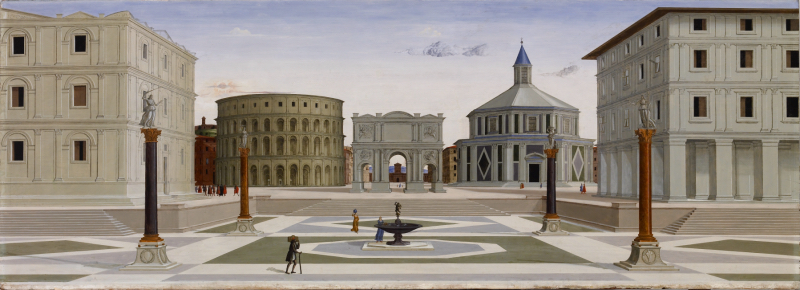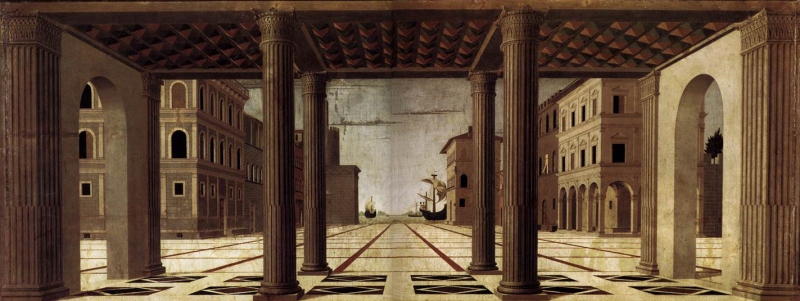
La Città ideale di Urbino
A symbol of an idea of what a Renaissance city should be, the famous image of the ‘Ideal City’, painted by an unknown artist between 1480 and 1490, at the court of Federico da Montefeltro, is a work that boasts two alternative versions, painted by other unknown authors or perhaps by the author himself.
This work is a symbol of the ideal Renaissance city, contrasting with the chaotic city of the Middle Ages, which appears before our eyes, and in all its vitality, in the urban view frescoed by Ambrogio Lorenzetti in the Palazzo Pubblico in Siena in 1337-1339.
THE IDEAL CITY OF THE RENAISSANCE

Lorenzetti, Effetti del Buon Governo in città
THE IDEA OF AN IDEAL CITY
The Middle Ages had left an unmistakable mark on Italian cities, and over the following centuries the city’s design was superimposed on the medieval one, which very often extended over a Roman plan. This layering still makes Italian cities fascinating and unique today. However, during the Renaissance, an idea of the ideal city emerged, conceived as a perfect harmony of forms, but unrelated to the social needs of the population.
There was also no lack of those who produced an ideal city in reality. This is the case of Sabbioneta, near Mantua, built between 1556 and 1591 at the behest of Vespasiano Gonzaga and which sums up all the characteristics of the ideal Renaissance city.
ANALYSIS OF THE IDEAL CITY OF URBINO
The ideal city of Urbino allows us to understand the importance that the concept of architectural design assumed during the Renaissance, as an effect of the discovery of perspective representation.
The work, preserved in the Galleria Nazionale delle Marche, is characterised by perfect compositional symmetry, achieved by applying the rules of linear centric perspective. Hence, it has only one central vanishing point, on which all the constructive lines in the drawing converge.
The geometric squares of the pavement produce the impression that the space narrows towards the back, while the buildings on the sides face a wide open space dominated by a central plan building. The vanishing point is located right in the middle of the half-open door of this circular building.
Everything seems to be skilfully constructed by man and the only natural elements are a few seedlings placed on windowsills and balconies, which are only necessary to indicate that these buildings are inhabited.

La Città ideale di Baltimora
ALTERNATIVE IDEAL CITIES
There are other views similar to the one in Urbino that seem to be inspired by it or perhaps are the work of the same author.
The first alternative version of the Ideal City is housed in the Walters Art Museum in Baltimore and depicts an ideal city with the Colosseum, a triumphal arch and the Baptistery of Florence in the background. In the central square we see four columns, on two of which stand the statues of Justice and Liberality. Elements that clearly remind us that it is only through them that good government can stand.
The second alternative version of the Ideal City is kept at the Bode Museum in Berlin and shows us the perspective row of palaces as if we spectators were inside an open gallery. We can even imagine that we are a wealthy Renaissance merchant sitting in the middle of this room, looking at the ships moored at the harbour at the end of the view.
Compared to the other two views, in this case, a central building is missing because the view extends to infinity and reminds us of the mercantile vocation of the Renaissance and the desire to push beyond known boundaries. Let us not forget the great Renaissance explorations, which enabled Christopher Columbus to discover the American continent in 1492.

La Città ideale di Berlino
The ideal city, therefore, is a Renaissance idea, typical of a period in which nothing seemed to affirm the advance of trade and knowledge.
The ideal city and its two alternative versions were an important reference point for two Renaissance artists: Perugino and Raphael.
The different representations of the ‘Ideal City’ allow us to explore the Renaissance vision of a perfect world, where architecture and town planning merge into a single harmony. From Urbino to Berlin, via Baltimore, these works not only express their creators’ desire for order and beauty, but also continue to inspire and fascinate with their ability to convey a timeless dream of perfection.
The concept of the ideal city remains a powerful symbol of the human capacity to imagine and design a better future.

